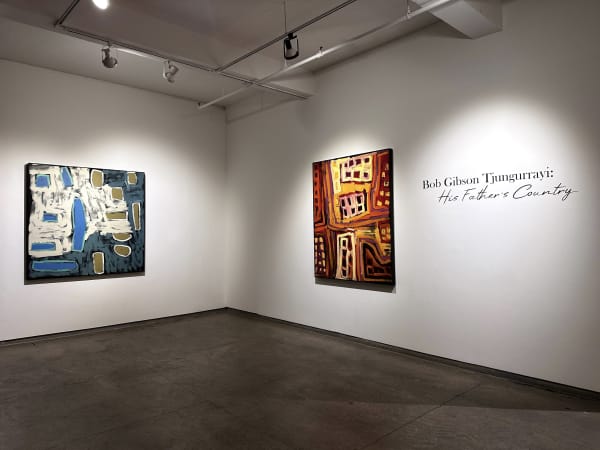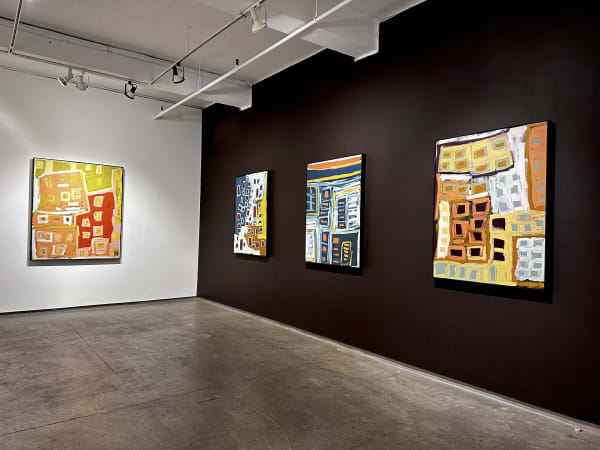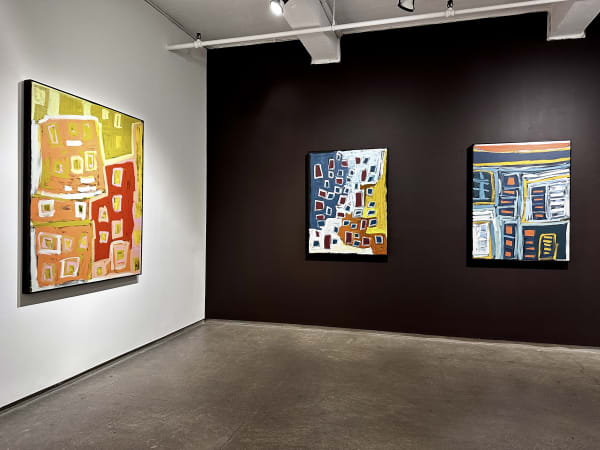SUPPORTED BY D’LAN CONTEMPORARY
Bob Gibson Tjungarrayi was born at Papunya in 1974, before moving with his family to the small community of Tjukurla during the outstation movement of the 1980s. This was a time when many Ngaanyatjarra people moved from government outposts near to Alice Springs back into the Western Desert to be closer to their ancestral homelands. Gibson's mother, Mary Gibson, is also a leading Tjarlirli artist whose Country is at Kulkurta, deep in the Western Desert, while his father’s country was near Patjarr on the edge of the Gibson Desert Nature Reserve.
Gibson began painting with Tjarlirli Art in 2007, and quickly found a unique rhythm and approach to mark-making; his style is characterized by bold colors and an inimitable freedom of movement, expressing ancient stories with contemporary flair. He is a vibrant character who is well loved within his community and provides support to many family members. Gibson is a keen Sydney Swans supporter and loves listening to all music, especially the local bush bands.
Looking at a Gibson painting feels a like like spending time with the artist himself. His bold, playful presence in the studio is contagious; each canvas brings wild shapes and expressive lines met with decisive mark-making and confident realization of country. His highly unique representations of Tjukurrpa (Dreaming stories) are an intersection of traditional storytelling and a spirited contemporary artistic practice. Gibson's work is significant for the way it speaks to the complex layers and tensions between cultural, historical and modern influences, and challenges characterizations of what "real" Aboriginal art looks like.
With the cooperation of Tjarlirli and Kaltukatjara Art
Photographs of the artist by Rosie Frecheville (Kaltukatjara Art Centre, 2021)
-
-
-
-
-
-
-
-
-
INSTALLATION
-

-
Bob came of age steeped in the knowledge of these desert lands, yet also with the formative experiences of modernity in Papunya. Bob’s mother Mary talks of many years travelling throughout the western desert region including regular trips to Tjarlirli Rockhole years before Tjukurla community was established nearby. In the early 1980s, a bore was sunk near Tjukurla, and previously displaced families gradually moved back the area from other communities and towns as infrastructure developed.
Many Tjukurla residents had art practices stretching back decades. Some painted, either through Papunya Tula or as independent artists, while others created purnu (wooden carved objects), wove tjanpi (native grass) baskets and sculptural forms, and created fabrics and seed necklaces at the women’s centre which was established in Tjukurla in 1993.[1] In 2006, a group of Tjukurla women sought to establish the community-owned art centre in the old women’s centre building. The goal of this initiative was to create a studio space for artists to work, provide materials, catalogue and keep track of works, and to broker and market work to the wider art world.
Bob joined Tjarlirli Art the year after its inception, when several fellow male artists joined the women in painting at the art centre. Bob quickly found a unique rhythm and approach to mark-making; his style is characterised by bold colours and an inimitable freedom of movement, expressing an ancient story with contemporary flair. He had received permission to paint his father’s country, Patjantja, an extremely remote site in Pintupi country on the edge of the Gibson Desert. This site relates to a Tjukurrpa story about two snakes and two men travelling north towards Karrkurinkitja in creation times. As they travelled, the party were approached by strangers, and the snakes fled across the landscape. Kurningka, boss of the Tingarri men, went hunting for them. As clouds approached and floodwaters began to rise, the female snake slipped inside the hole of an ant’s nest, but the male snake was left outside, too big to fit. Kurningka, reaching the remaining snake, cut into him, and fat spilled out.
-
The details of this Tjukurrpa are limited for the uninitiated, however Bob’s paintings provide a means to access the boldness and raw energy of the desert landscapes that hold this knowledge. His work is distinguished by its freedom of composition, as he applies paint at an almost frenetic pace, deploying dynamic shapes and bold colours to realise his vision. He almost always paints on his feet, moving swiftly around the canvas to apply paint from all sides, making intuitive, split-second decisions on colour and composition. His electric personality, playful sense of humour and joyfully unique perspective are present in his practice; other artists will often stop what they are doing to watch him paint.
Bob is forever a man doing a million things at once, and his boundless energy, cheeky humour and unique perspective are all conveyed through his canvases. Often, he will listen to rock bands from the bush through his headphones while painting, drumming along with paintbrushes; other times he can be found watching kung-fu movies in the art centre before collecting his brushes and deploying those same sharp, punchy moves in creating a painting. In the sleepy heat of the desert, many live deliberately slow-paced everyday lives - but never Bob! He darts everywhere around community, his quick footsteps covering the familiar distances from his home to the shop, the art centre, the park, soundtracked by desert reggae. While his works are often instantly recognisable as “Bobs,” none are the same or replicable; each day brings a new aspect of Bob’s character to the work, allowing him to capture a specific moment or emotion on the canvas. Moving like a passionate conductor leading a particularly energetic piece, his paintings emerge organically from moment to moment, his entire being engaged and present.
In the early days, Bob was a highly transient painter; he would pull up in community, fly out of the passenger seat into the art centre to paint half a dozen canvases at breakneck pace before wheeling off to his next engagement. Now, Bob is a daily presence in the art centre and one of only a handful of men painting regularly. His confidence has grown with his exponential career and the art centre is now truly his place.
Dynamic, colourful, and contemporary, Bob’s works are given a sense of depth and layered meaning through the immemorial Tjukurrpa he carries. His paintings embody the meeting of traditional culture and ceremony with the fast-paced modern realities of present-day life in remote western desert communities. His practice, spanning almost twenty years, demonstrates an evolution from a talented amateur to an assured and commanding artist and leading figure at Tjarlirli Art. This collection of works represents a challenge to binary conceptions of Aboriginal Australian art, presenting an oeuvre which is both culturally meaningful and electrifyingly contemporary.
[1] John Carty, Ngaanyatjarra Art of the Lands, UWAP, 2012, p.241.













